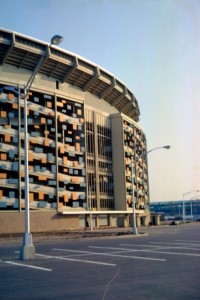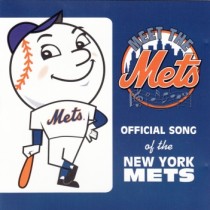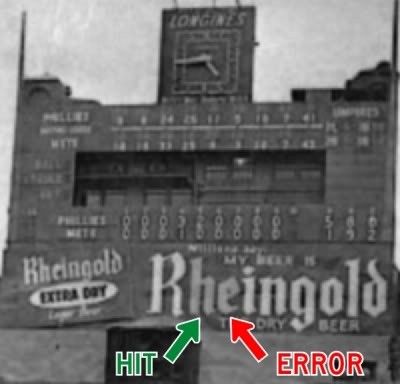I Meet The 1962 New York Mets
My first romance started the instant the 1962 New York Mets took the field, when it appeared as if the team had gotten everything right. At the behest of Mets Team President George Weiss, the franchise settled on the colors of the teams it replaced, Brooklyn Dodgers blue and New York Giants orange, as its own. The players’ cap was Dodgers blue topped off by what had once been the New York Giants’ “NY.” The home uniforms had a pinstripe in them that was a nod to Yankees tradition.
The logo, designed by sports cartoonist Ray Gatto, looked good, too. The large bridge in the foreground represented the city’s five boroughs, connected by a series of bridges. The skyline was a combination of real and generic buildings. The spire atop the church at the far left represents Brooklyn, said to house a vast number of them. To its right is the Williamsburgh Savings Bank, a famous symbol of the borough. The Woolworth Building is next, followed by a series of generic buildings drawn to represent the city’s skyline. In its middle is the Empire State Building. On the right is the United Nations Building.
I have a vague remembrance of a request by one of the newspapers, probably the New York Daily News, to submit names for the new club. They came pouring in by the hundreds if not thousands. The suggested names were whittled down to a handful, and included the Skyliners, Skyscrapers, Jets (the AFC team was still the Titans back then), Blue Sox, Mets (short for Metropolitans), Avengers, and a few more. Team owner Joan Whitney Payson got her pick, and she liked Mets, so Mets it was.
The Mets were easy to find. Since I was ten years old in 1962, I was not permitted to travel from suburban Long Island to Upper Manhattan on my own, so all I had to do was turn on Channel 9, WOR, or listen to Radio Station WINS, 10:10, with Lindsey Nelson, Bob Murphy and Ralph Kiner. Now here’s where my memory gets a bit fuzzy. I have strong remembrances of all things early Mets, circa ’62 and ’63, but some blurring has started to cloud up with the years. I clearly remember each broadcast beginning with someone saying “the New York Mets are on the air.” I believe our own special song, “Meet the Mets,” debuted in ’63.
Considered by some as the Mets original fight song, the charming little number worked its way into my consciousness, and became a sort of theme song. It’s been around all these years, although it was modified somewhat in the eighties, given a disco beat for a time, but it will always sound like that early tune from the hapless years to me. I’m not the only member of my family who remembers the tune, either. My younger sister, Jane, has fond memories of it, too. Here are the words to the song, whose words and music were written by Ruth Roberts and Bill Katz.
MEET THE METS, MEET THE METS, Step right up and greet the Mets!
Bring your kiddies, bring your wife; Guaranteed to have the time of your life
Because the Mets are really sockin’ the ball; knocking those home runs over the wall!
East side, West side, everybody’s coming down, to meet the M-E-T-S Mets of New York town!
Oh, the butcher and the baker and the people on the streets, where did they go? To MEET THE METS!
Oh, they’re hollerin’ and cheerin’ and they’re jumpin’ in their seats, where did they go? To MEET THE METS!
All the fans are true to the orange and blue, so hurry up and come on down – ’cause we’ve got ourselves a ball club,
The Mets of New York town!
Give ’em a yell! Give ’em a hand! And let ’em know your rootin’ in the stand!
MEET THE METS, MEET THE METS, Step right up and greet the Mets!
Bring your kiddies, bring your wife; Guaranteed to have the time of your life
Because the Mets are really sockin’ the ball; knocking those home runs over the wall!
East side, West side, everybody’s coming down, to meet the M-E-T-S Mets of New York town!
Of New York town!
I spoke to Jane not too long ago about the song. “We sang the song when Mom yelled,” she recalled. “I don’t think she knew we were doing it. It became a thing for us. That’s how I got my knowledge of the song.” How Jane, who was five years of age at the time, can remember this when I couldn’t is a wonder to me. The two thoughts that registered when Jane told me about all this was that I must have sung the song a lot (sorry, Mom) and that it explains how I know almost all of the words to the song to this very day.
 Jane had another recollection that dealt with the orange and blue metallic squares that adorned the exterior of Shea Stadium. She thought those “boxes” were box seats, and that people sat inside of them to watch the baseball game. “That’s what I thought a box seat was.” Some of Jane’s box seats are shown in the photo on the left.
Jane had another recollection that dealt with the orange and blue metallic squares that adorned the exterior of Shea Stadium. She thought those “boxes” were box seats, and that people sat inside of them to watch the baseball game. “That’s what I thought a box seat was.” Some of Jane’s box seats are shown in the photo on the left.
So I was all set. I had a team, colors, a logo, a song, a little sister who would sing it with me, a TV channel, a radio station, play by play announcers, and after a short time a mascot and a stadium named after Bill Shea, the lawyer credited with getting New York City a replacement team. It would be up to the team and our players to make it all the more memorable. They did. Those adventurous early years were fun. I have too many memories for one post, so for now, I’ll share one of them with a promise to divulge more as the months unfold.
The Mets were a hilarious disaster, a well-meaning group of bumblers who had the uncanny ability in the field to turn an impossible situation into something immediately worse in an instant. They dropped pop flies. They threw to the wrong bases. They ran into each other. If there was a chance for things to go wrong, they would. Back then the beer that sponsored my Metsies was Rheingold, and the huge protuberance in deepest center field in the Polo Grounds became known as the Rheingold Scoreboard. If there was a play where one of the Mets fielders committed a miscue, or there was a doubt about whether the play was a hit or an error, that’s where your eyes would go to await the Official Scorer’s decision. The appropriate letter, as shown in the photo below, would light up and there you had it. I heard the saying “and the Big E lights up on the Rheingold Scoreboard” so many times back then that to this day I can recite it not only in my sleep, but in yours, complete with the proper Lindsey Nelson inflection. The expression was heard so often that it became ubiquitous, dropping its way into everyday circumstances. To this very day, whenever I do a physical task and make an unexpected, uncoordinated move, such as dropping a cup of coffee or washing a new red t-shirt with old white ones resulting in one red and bunch of pink t-shirts, my mind goes straight to that wonderful, comforting old saying, and I don’t know whether to laugh or cry, so I usually do a touch of both as I hear once more, forever and again, “the Big E lights up on the Rheingold Scoreboard.”




Comments